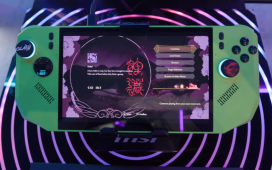Expert’s Rating
Pros
- Beautiful 240Hz OLED display with HDR
- Connectivity includes two Thunderbolt 4 ports
- Excellent CPU and GPU performance
- Slightly less expensive than competitors
Cons
- Drab exterior design fails to stand out
- Mediocre touchpad
- Speakers sound shrill at high volumes
- Lacks extras found on some competitive laptops
Our Verdict
The HP Omen Max 16 is a workmanlike entry into the 16-inch gaming laptop arena. It performs about as well as its peers, however, and ranks among the more affordable laptops with RTX 5080 graphics.
Price When Reviewed
This value will show the geolocated pricing text for product undefined
Best Pricing Today
The near-simultaneous appearance of new Intel Core Ultra 9 processors and Nvidia RTX 5080 mobile graphics has led to a burst of mid- to high-end gaming laptops with extremely capable hardware. The HP Omen Max 16 is among these, and while it performs about as well as its peers, it also struggles to set itself apart on pricing and design.
HP Omen Max 16: Specs and features
The core of the HP Omen Max 16 is the one-two punch of an Intel Core Ultra 9 275HX processor and Nvidia RTX 5080 mobile graphics. Both chips are new and deliver excellent all-around performance in their respective categories.
- Model number: 16-ah0043dx
- CPU: Intel Core Ultra 9 275HX
- Memory: 32GB DDR5-5600
- Graphics/GPU: Nvidia RTX 5080 (Max 175W with Dynamic Boost)
- NPU: Intel AI Boost up to 13 TOPS
- Display: 16-inch 2560×1600 240Hz OLED with HDR
- Storage: 2TB M.2 PCIe 4.0 SSD
- Webcam: 1080p 30fps camera with Windows Hello support
- Connectivity: 2x Thunderbolt 4 with USB-C and Power Delivery, 2x USB Type-A (10Gbps), 1x HDMI 2.1, 1x RJ-45 Ethernet, 1x 3.5mm headphone/microphone combo jack
- Networking: Wi-Fi 7, Bluetooth 5.4
- Biometrics: Facial recognition
- Battery capacity: 83 watt-hours
- Dimensions: 14.04 x 10.59 x 0.98
- Weight: 6.1 pounds
- Operating System: Windows 11 Home
- Additional features: HyperX wireless connectivity
- Price: $3,339.99 MSRP
CPU and GPU aside, the HP Omen Max 16’s specification sheet is typical. The model I reviewed had a 16-inch display with 2560×1600 resolution, 32GB of memory, and a 2TB PCIe 4.0 solid state drive.
Connectivity is the only place where HP deviates from the norm, as the Omen Max 16 has two Thunderbolt 4 ports (some competitors have just one). It also has a HyperX wireless adapter for instant pairing with HyperX gaming hardware, which is a niche feature but potentially useful, as HyperX gaming peripherals are often rather good.
The HP Omen Max 16 I reviewed was priced at an MSRP of $3,339.99 at Best Buy, though it was reduced to $3,139.99 at the time I wrote this review. That’s expensive, but on the less expensive side for this caliber of hardware.
The HP Omen Max 16 is a capable, though rather dull, option in the highly competitive field of mid- to high-end gaming laptops with Nvidia RTX 50-series hardware.
HP Omen Max 16: Design and build quality
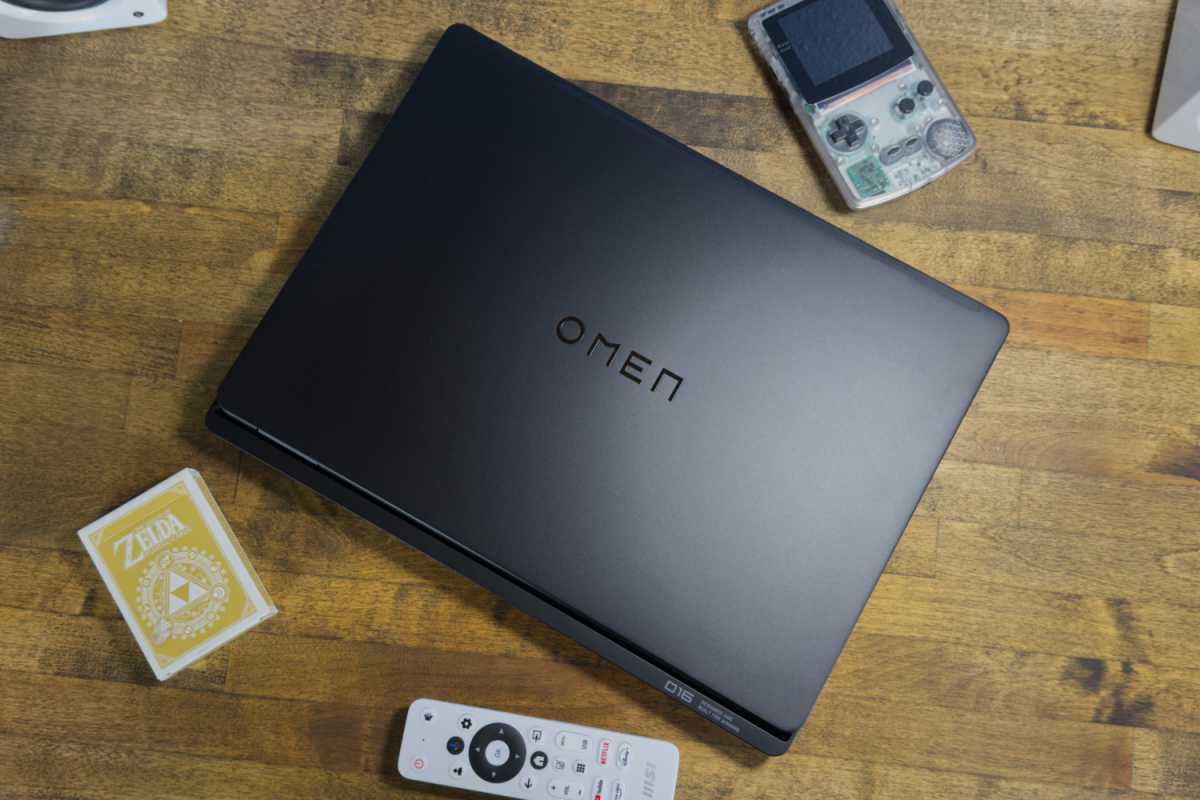
IDG / Matthew Smith
If imitation is the highest form of flattery, Alienware is no doubt blushing. HP’s Omen lineup has gradually morphed into something that looks much like older Alienware laptops. With the Omen Max 16, the inspiration comes across in the availability of black and white colorways, the simple lines with rounded corners, and, most notably, the similar choice of font used in the laptop’s “O16” badging.
However, the Omen Max 16 isn’t as extravagant as a typical Alienware machine. While the Omen Max 16 offers a customizable RGB-LED lightbar across the front, as well as an RGB-LED keyboard, the badging across the laptop’s exterior is rather tame. The Shadow Black colorway is particularly stealthy, as HP’s choice of matte black materials comes across as dull. Many competitors have their own flourishes: the Asus ROG Strix Scar 16 has a white LED display on its lid, for example.
That leaves the Omen Max 16’s design in a tough spot. It’s not unattractive, but it’s the least alluring of the new RTX 5080-powered gaming laptops PC World has reviewed to date.
On the plus side, HP hasn’t cut corners on build quality. The laptop chassis doesn’t allow much flex when picked up from one corner, and the materials don’t groan or creak. Opening and closing the laptop reveals only slight flex in the display, and the keyboard also resists flex unless specifically abused. Competitors like Alienware, Lenovo, and Asus provide solid build quality in this price bracket, too, but the Omen Max 16 is at least their peer.
HP Omen Max 16: Keyboard, trackpad
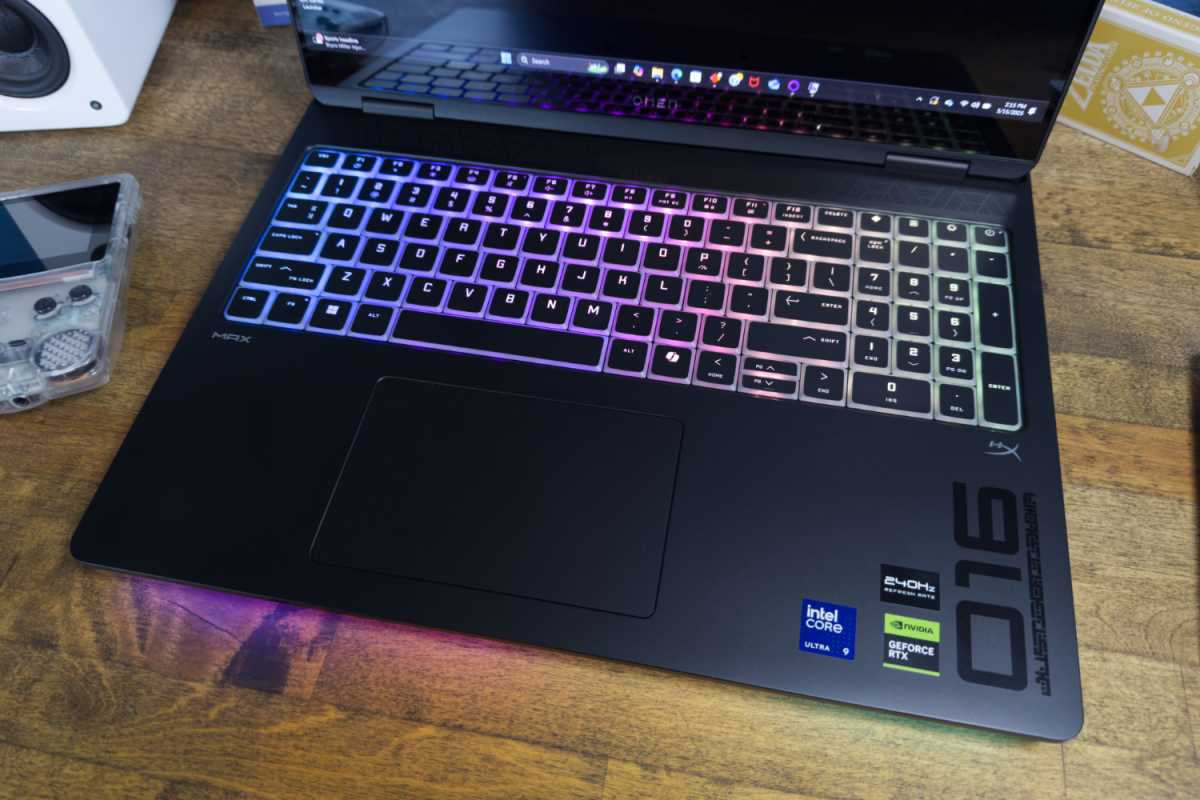
IDG / Matthew Smith
The HP Omen Max 16’s keyboard, much like the rest of its design, doesn’t look like much, especially when the RGB-LED backlight is not in use. This is mostly due to the keycaps, which have a rather old-fashioned bevel.
However, the Omen Max 16 strikes back in typing feel. The laptop offers good key travel and a firm, tactile bottoming action with a distinct scissor-switch slap. The Omen Max 16 isn’t going to match a mechanical keyboard, of course, but it feels crisp.
While the keyboard didn’t strike me as attractive, the customizable RGB-LED backlight helps alleviate that problem. It’s extremely bright and vibrant, as the keycaps have transparent edges that allow significant light through. The keyboard is also easy to customize through HP’s Omen Light Studio software.
The touchpad is less impressive. It feels responsive but only measures roughly five inches wide and three inches deep. That’s the minimum for a laptop. A couple of competitors, like the Asus ROG Strix Scar 16 and Razer’s Blade 16, offer a much larger touchpad surface.
HP Omen Max 16: Display, audio
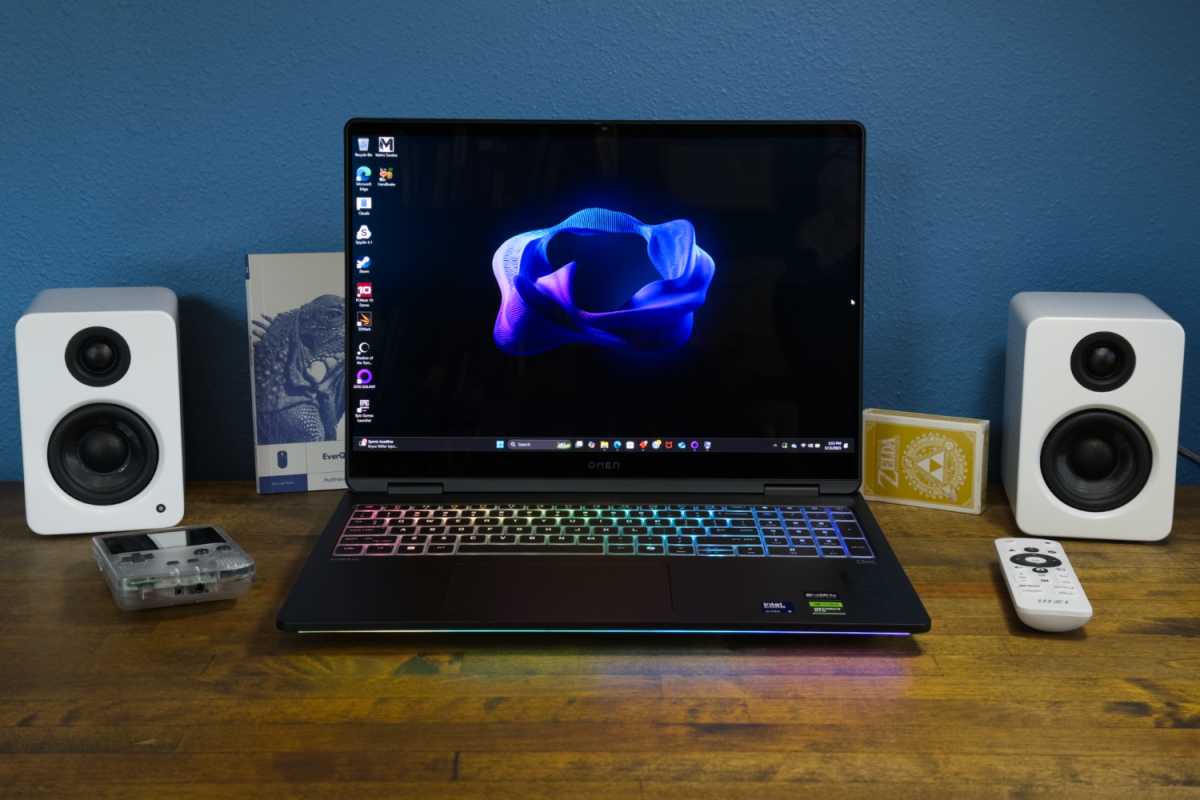
IDG / Matthew Smith
Display quality is a perk for the HP Omen Max 16, though only if you spring for the top-shelf 16-inch OLED display. It has a resolution of 2560×1600, a maximum refresh rate of 240Hz, and supports variable refresh rates between 48Hz and 240Hz.
Going OLED has its strengths and weaknesses. OLED displays are typically glossy, which can make glare an issue, and not as bright as the Mini-LED displays found on competitors like the Asus ROG Strix Scar 16.
On the other hand, OLED provides top-tier contrast, color gamut, and motion clarity that are difficult to beat at any price. These advantages are well suited for a gaming laptop, so I prefer the HP’s OLED display over alternatives with an IPS Mini-LED or IPS LCD display.
The OLED display also supports HDR when the laptop is plugged into an outlet. It’s not going to match the HDR brightness of new desktop OLED monitors, but it’s not bad and looks vibrant enough to help HDR games pop.
The HP Omen Max 16’s speakers sound balanced at lower volumes but begin to sound shrill as the volume is increased. They’re fine for chill background beats or games that lean less on immersive audio, but you’ll want desktop speakers or a headset for anything more acoustically demanding. This is an area where the Asus ROG Strix Scar 16 has a significant advantage, as it has a powerful, crisp sound system.
HP Omen Max 16: Webcam, microphone, biometrics
HP ships the Omen Max 16 with a 1080p webcam and dual microphone array. Neither stands out, but both do the job. You can expect the webcam to deliver sharp, colorful video, and the microphone array will pick up your voice with plenty of volume.
The Omen Max 16 also has an IR camera for Windows Hello facial recognition. Most competitive laptops support this feature, too, but it’s always good to see. Facial recognition was fast and reliable in my testing, which, again, is also true of competitive laptops. A physical privacy shutter is included, too, to obstruct the webcam when desired.
HP Omen Max 16: Connectivity
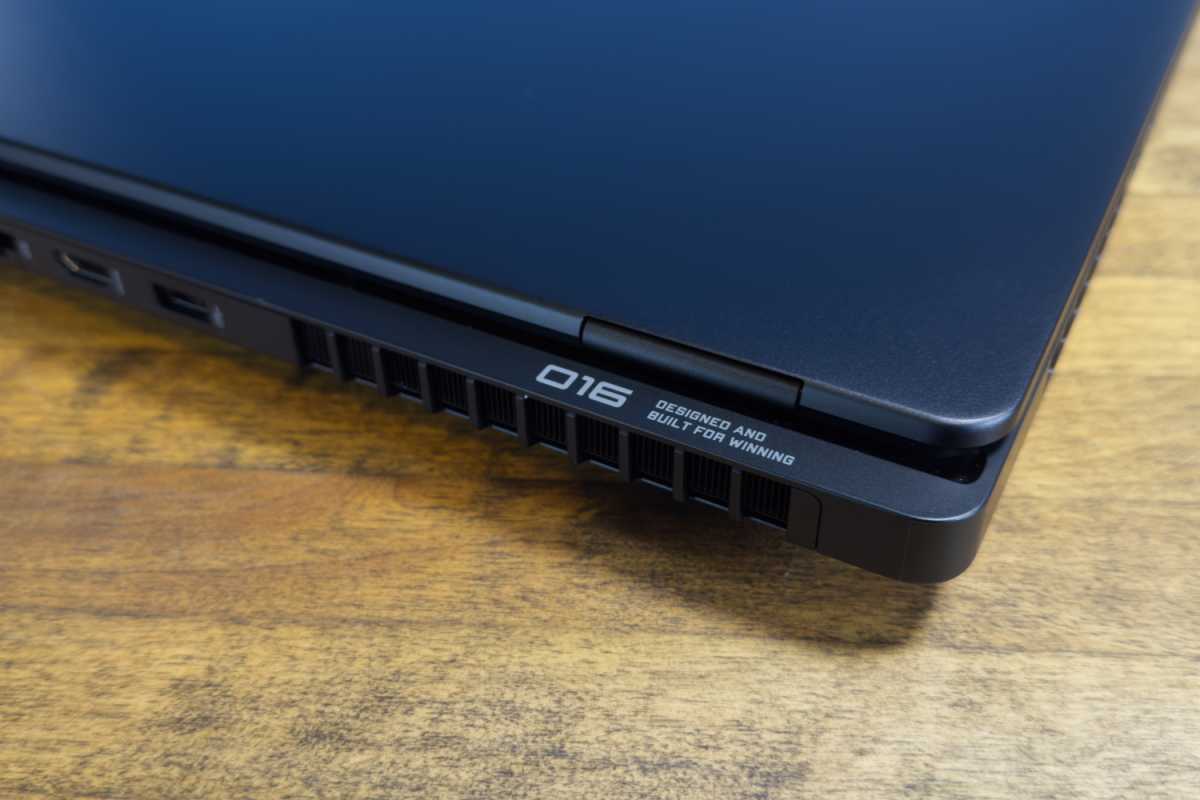
IDG / Matthew Smith
You’ll find a healthy selection of ports along the HP Omen Max 16’s flanks.
A pair of Thunderbolt 4 ports, both of which support USB-C, are found on the left flank and joined by the 3.5mm combo headphone/microphone jack. The right flank has a single USB-A port. Another USB-A port is found on the rear, alongside HDMI 2.1 and 2.5Gbps Ethernet. The laptop also has a barrel plug power adapter on the rear, which connects to the included 330-watt power brick.
This is a good selection of ports for a modern gaming laptop. I also like that some ports are found on the rear of the laptop, which makes cable management easier. Helpfully, two of the three ports are those you’re most likely to use (HDMI and Ethernet) if the laptop spends a lot of time on a desk.
The Thunderbolt 4 ports also support USB-C power delivery. HP’s specifications don’t state the amount of power available, but it’s irrelevant, as the laptop’s maximum power draw likely exceeds what USB-C could provide. Still, it’s nice to have USB-C as a secondary option for charging the laptop if you happen to forget the brick.
Like most new laptops sold in 2025, the HP Omen Max 16 supports Wi-Fi 7 and Bluetooth 5.4. But here’s a twist: the laptop also supports instant wireless pairing with HyperX devices. I didn’t have a compatible HyperX device on hand to test this feature, however.
HP Omen Max 16: Performance
The hardware inside the HP Omen Max 16 I reviewed is similar to competitive laptops PC World has recently reviewed, which includes the Lenovo Legion Pro 7i 16, the Asus ROG Strix Scar 16, and the MSI Raider 18 HX AI. It pairs an Intel Core Ultra 9 275HX processor with an Nvidia RTX 5080 GPU. The Omen Max 16 also had 32GB of DDR5 memory and 2TB of PCIe solid state storage.
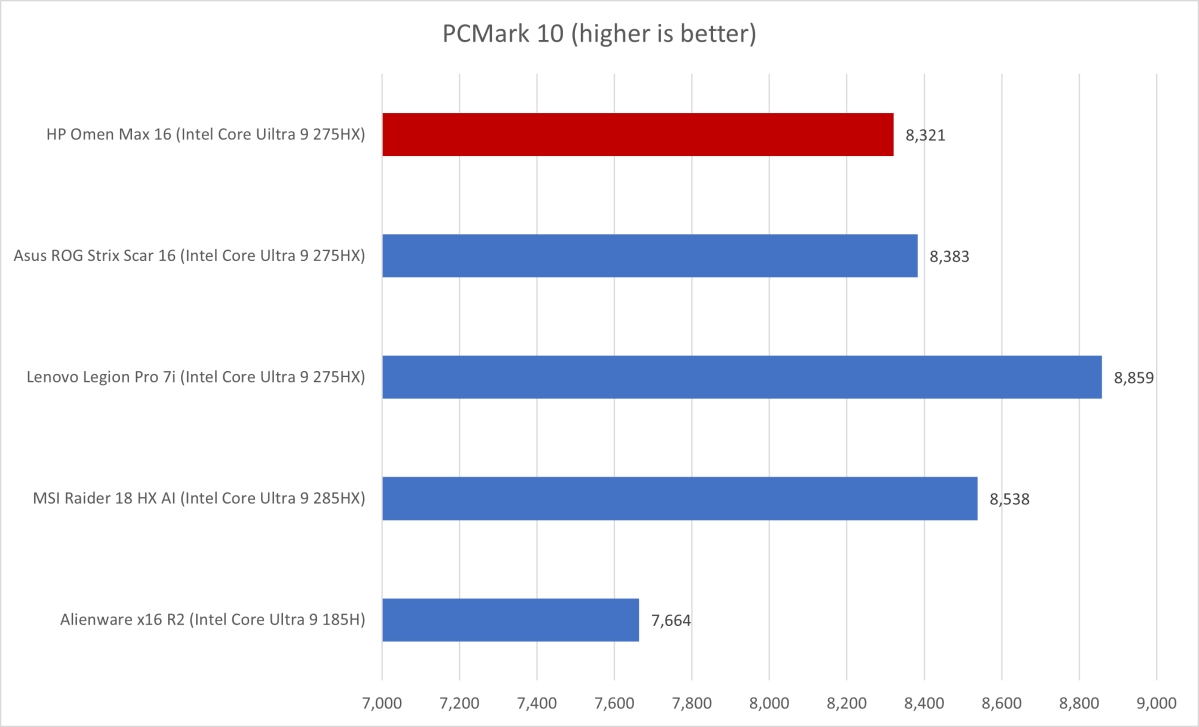
IDG / Matthew Smith
We kick things off with PCMark 10, a holistic system benchmark. Here, the Omen Max 16 reached a solid score of 8,321. That is towards the lower end of the competitive Intel Core Ultra 9 / Nvidia RTX 5080 laptops we have recently reviewed, but the margin is so slim that it’s essentially a tie.
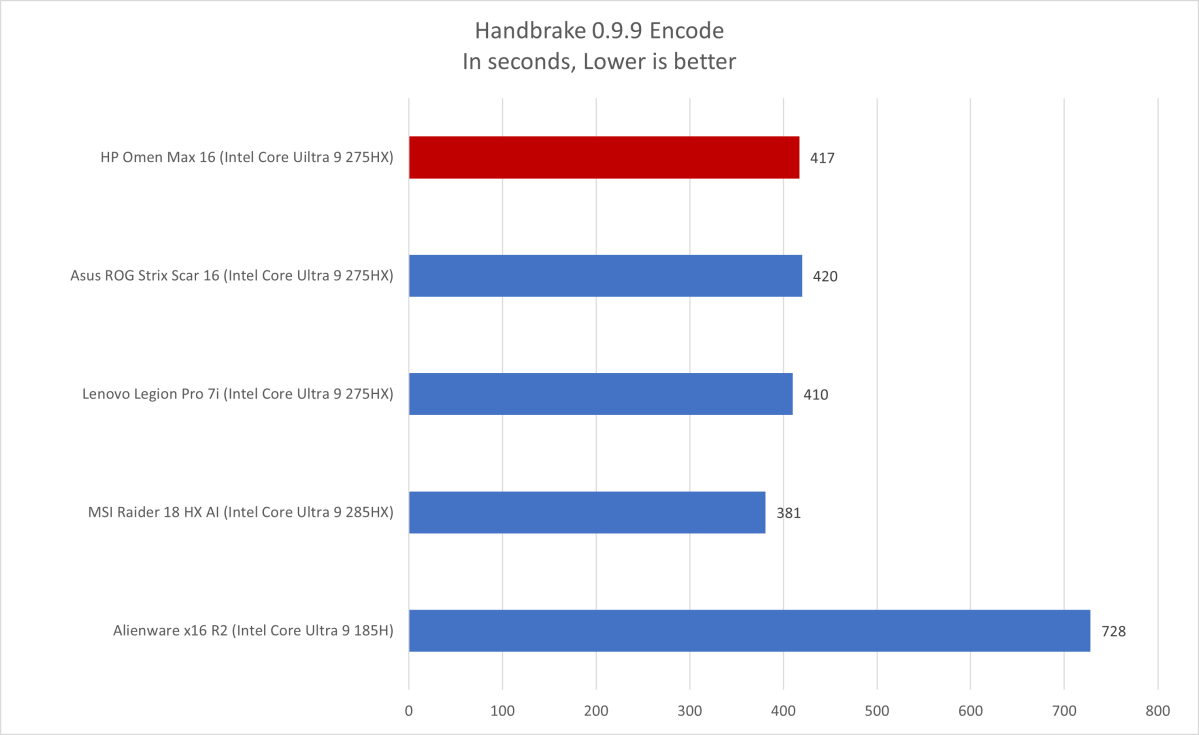
IDG / Matthew Smith
Handbrake is a heavily multithreaded benchmark that typically has a longer duration. The latest Intel Core Ultra 9 chips really chew through it, however, and the HP Omen Max 16 is no exception. It’s right on par with most of its competitors. Only the MSI Raider 18 HX A2XW, which had the benefit of a larger chassis and slightly more capable Intel Core Ultra 9 285HX processor, comes out ahead of the pack.
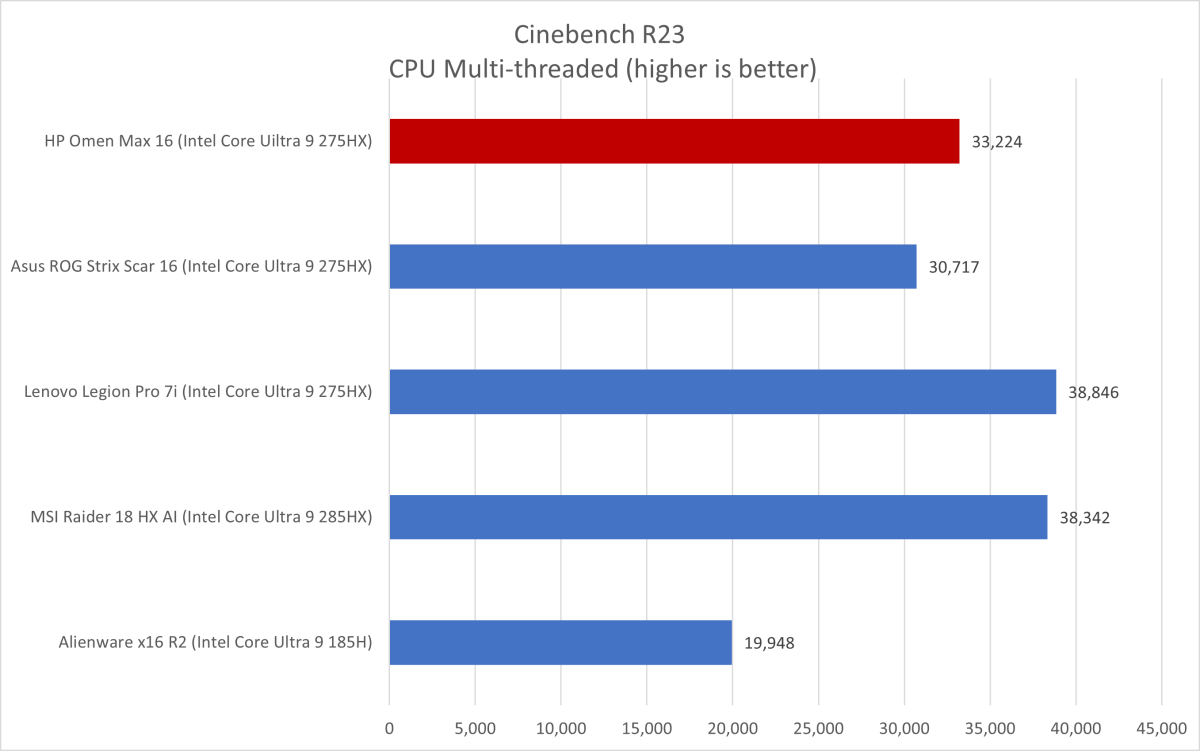
IDG / Matthew Smith
Cinebench R23 is another heavily multi-threaded benchmark, albeit a more modern one, and it doesn’t change the HP Omen Max 16’s story. The Omen performs extremely well here with a score of 33,224, but it’s not much different from its direct competitors. The Lenovo Legion Pro 7i 16 is once again a tad quicker than the HP and the larger, more expensive MSI Raider 18 HX A2XW takes a victory lap.
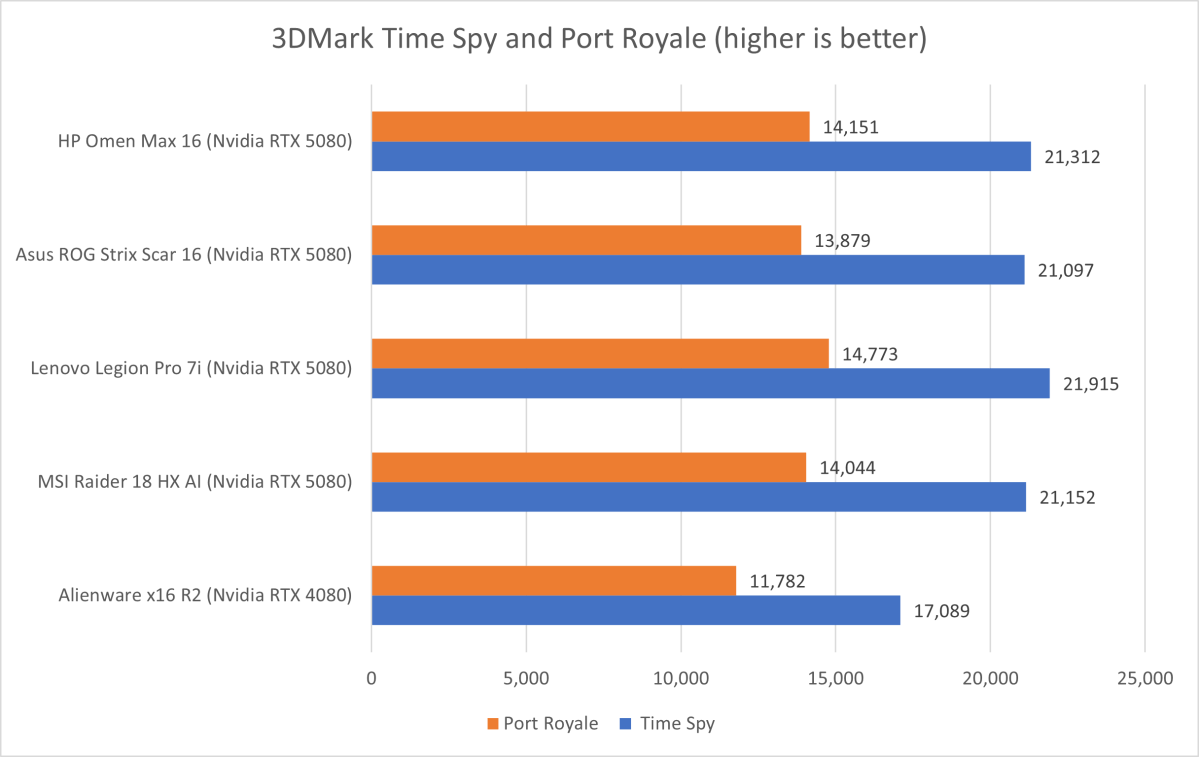
IDG / Matthew Smith
Moving on to graphics performance, the Omen Max 16 with RTX 5080 delivers 3DMark Time Spy and Port Royal results that are right in line with competitive laptops. The Lenovo Legion Pro 7i 16 is an overall leader here, but the HP Omen Max 16 does well.
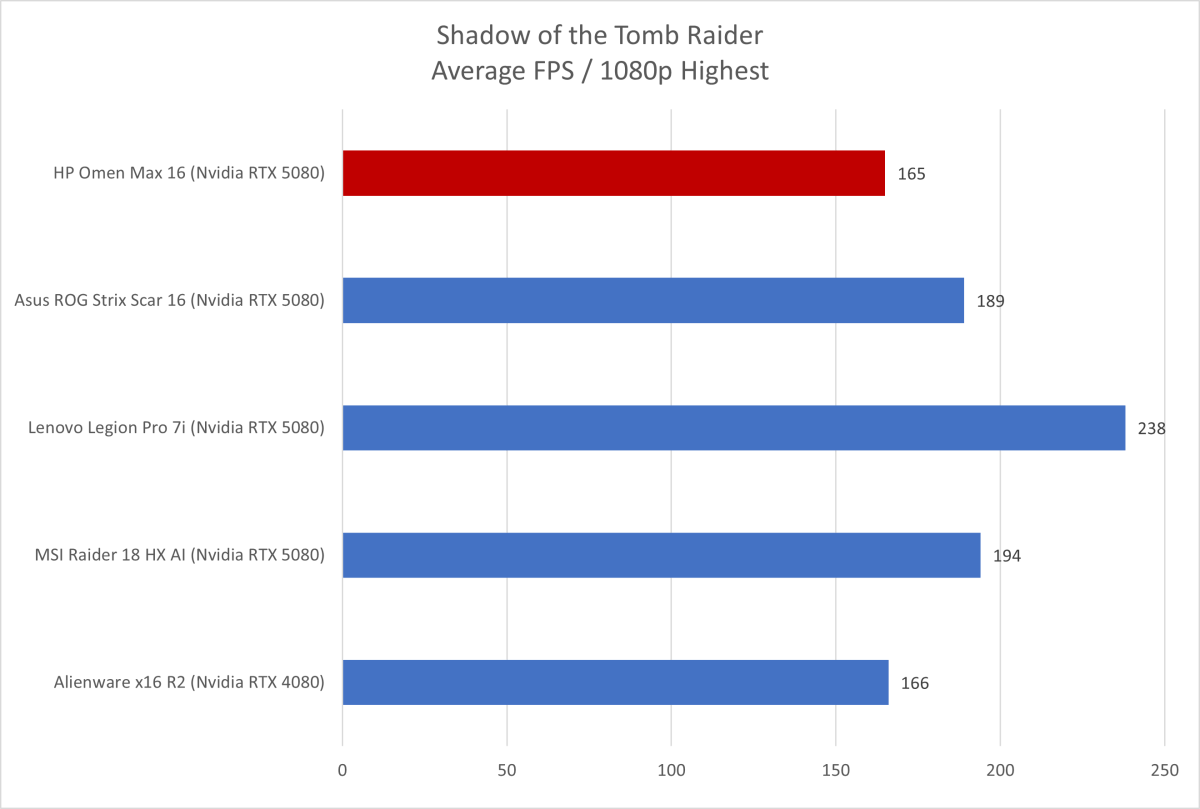
IDG / Matthew Smith
Shadow of the Tomb Raider, however, was a weak point for the Omen Max 16. The laptop averaged 165 frames per second at 1080p resolution with detail set to highest and DLSS off. That’s notably behind the competition, and the Omen Max 16’s first real defeat.
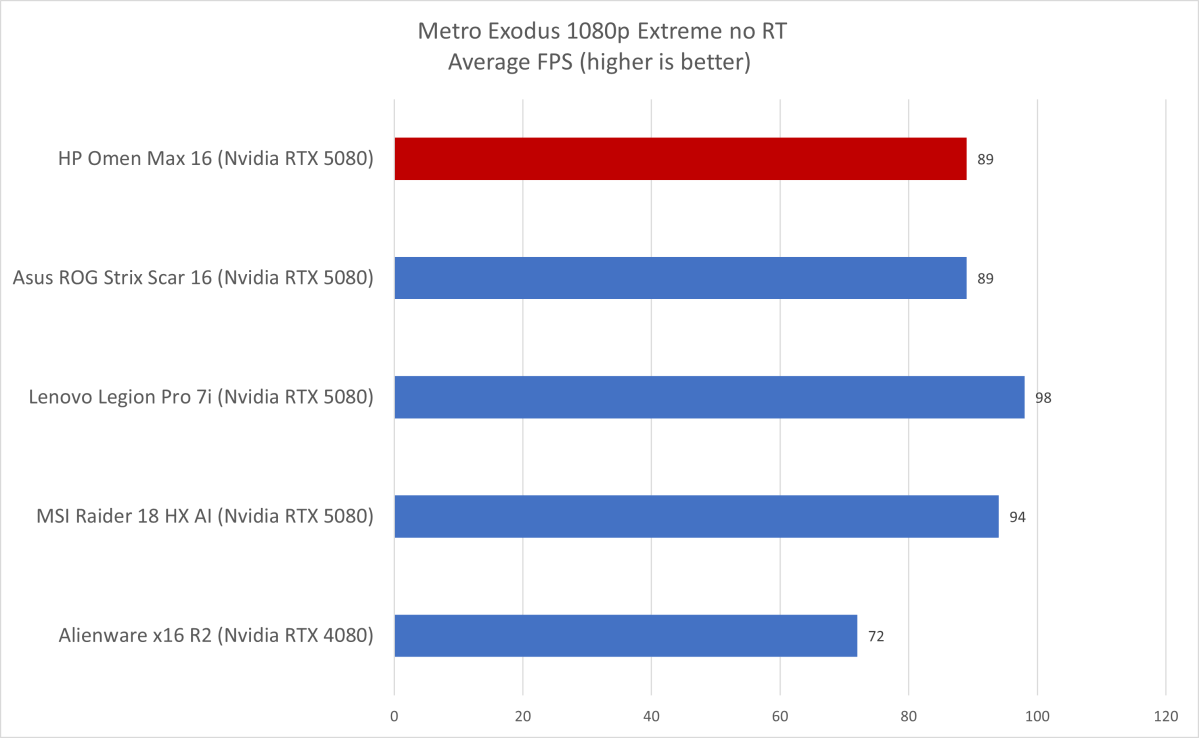
IDG / Matthew Smith
But Tomb Raider may not be indicative of general game performance, as the Omen Max 16 leapt back into the pack with the Metro Exodus benchmark. Here it averaged 89 frames per second at 1080p and Extreme detail. Some competitors, like the Lenovo Legion Pro 7i 16, have an edge here. But others, like the Asus ROG Strix Scar 16, end up tied with the Omen Max 16.
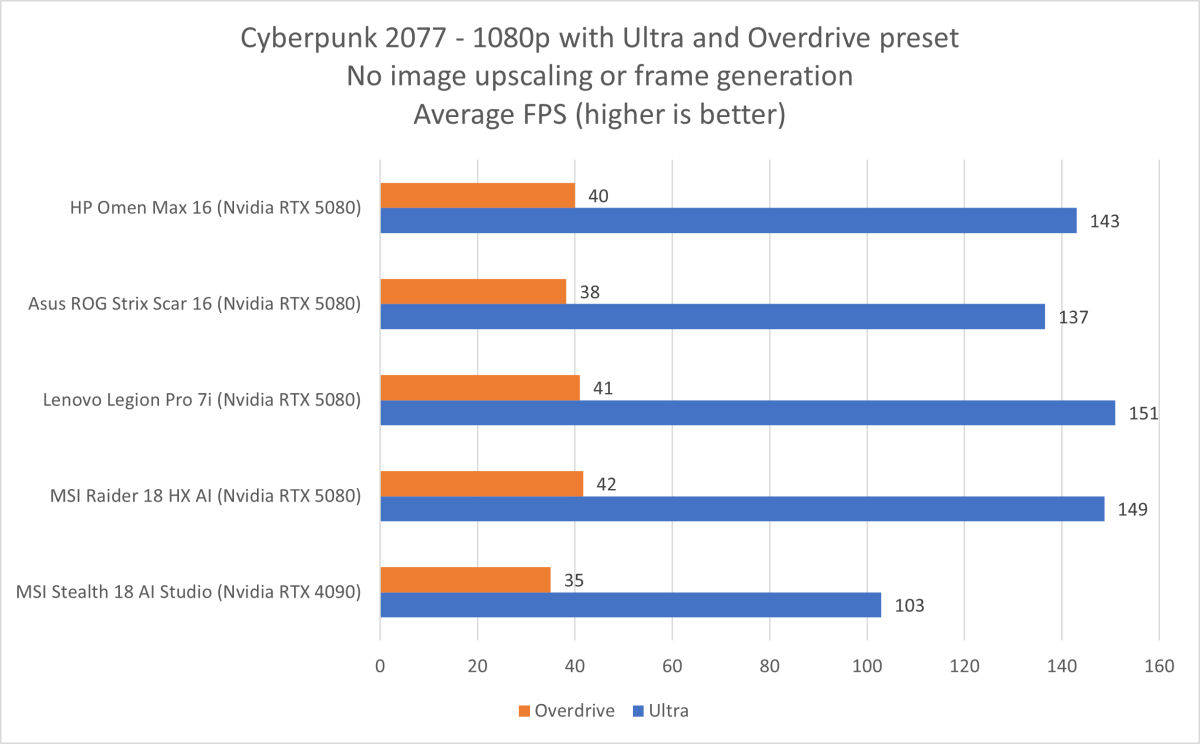
IDG / Matthew Smith
Last, but certainly not least, is Cyberpunk 2077. Here the Omen Max 16 averaged 143 frames per second at 1080p resolution and the Ultra preset with DLSS/FSR/XeSS turned off. Turning the detail up to max with the Overdrive ray-traced preset greatly reduced performance to an average of just 40 frames per second. Both results are competitive. The Omen Max 16 beats the Asus ROG Strix Scar, but falls behind the Lenovo Legion Pro 7i 16.
Remember, this is with DLSS set to off. Higher detail presets, such as Cyberpunk 2077’s Overdrive preset, benefit greatly from DLSS image upscaling and frame generation. Engaging these features increased performance from 40 to as high as 178 frames per second.
The HP Omen Max 16’s overall performance is precisely what I expected. It’s very similar to other laptops tested with an Intel Core Ultra 9 processor and Nvidia RTX 5080 graphics. The Lenovo Legion Pro 7i 16 is generally a bit quicker, and the Asus ROG Strix Scar 16 is a tad slower, but the margins are often slim. This ultimately works out slightly in HP’s favor, however, because it’s a bit less expensive than its competitors.
HP Omen Max 16: Battery life & portability
The HP Omen Max 16 has an 83-watt-hour battery, which is towards the smaller side for a high-end gaming laptop. However, the laptop also provides Nvidia Optimus graphics, which can increase battery life by disengaging the discrete GPU when its performance isn’t required.
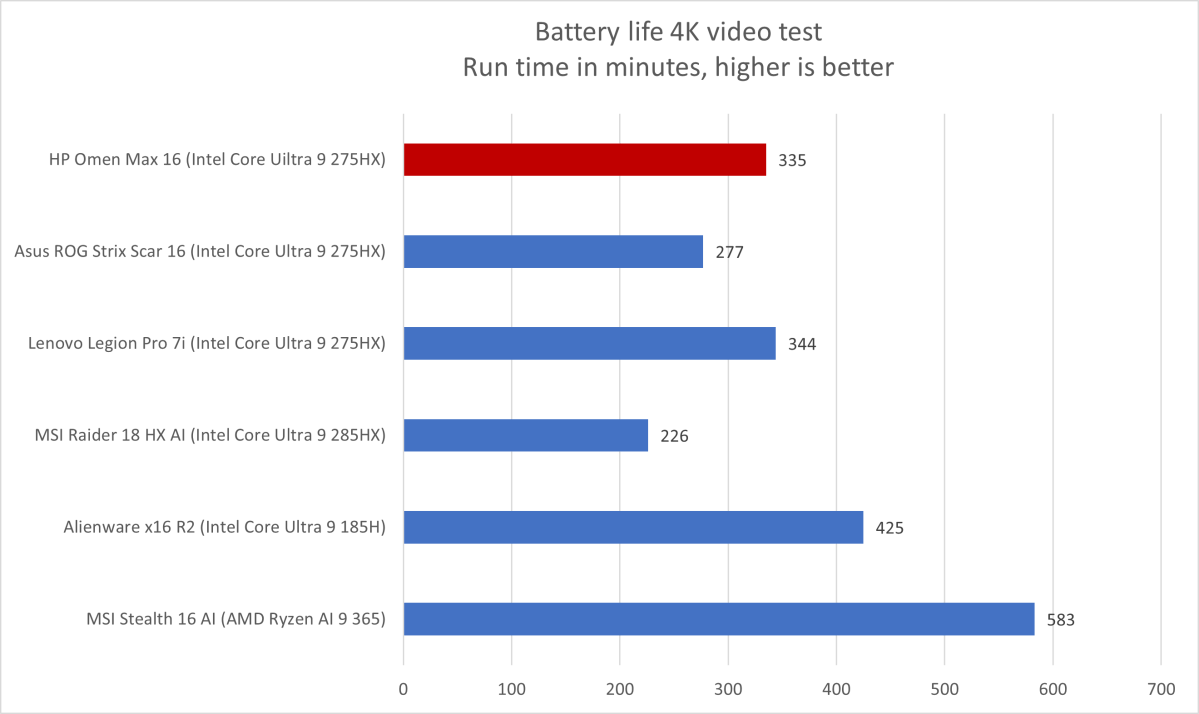
IDG / Matthew Smith
This does provide some benefit. The HP Omen Max 16 endured our battery test, which loops a 1080p file of the short film Tears of Steel, for roughly five and a half hours. That’s longer than the Asus ROG Strix Scar 16 and MSI Raider 18 AI HX, but not as long as the Lenovo Legion Pro 7i 16.
In any case, five to six hours of battery life isn’t a lot. The Omen Max 16 is also a bit difficult to pack at 6.1 pounds and nearly an inch thick at its thickest point. Add in the 330-watt power brick and you’ll be hauling roughly eight pounds.
HP Omen Max 16: Conclusion
The HP Omen Max 16 is a capable, though rather dull, option in the highly competitive field of mid to high-end gaming laptops with Nvidia RTX 50-series hardware. It provides performance that’s broadly like the alternatives yet lacks features that might help it separate it from the pack. It doesn’t have the flair of the Asus ROG Strix Scar 16 or the performance of the Lenovo Legion Pro 7i 16.
Yet there’s one thing about the HP Omen Max 16 that’s very attractive: the price. Listed at an MSRP of $3,339.99 and currently sold (and in stock!) on Best Buy for $3,139.99, the Omen Max 16 is towards the low end of pricing for a 16-inch gaming laptop with an Intel Core Ultra 9 and RTX 5080. And, as mentioned, it performs about as well as its more expensive peers. If it were my money, I’d opt for the Asus ROG Strix Scar 16, which is more attractive and has a few extras I prefer, such as a comfortable touchpad and high-quality speaker system. If you just want good bang-for-your-buck and don’t sweat the details, however, the HP Omen Max 16 is a solid pick.






